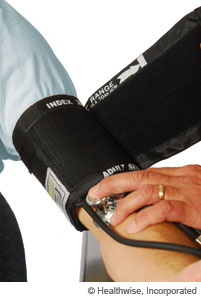Test Overview
Using a home blood pressure monitor lets you keep track of your blood pressure at home. Blood pressure is a measure of how hard the blood pushes against the walls of your arteries as it moves through your body.
Your blood pressure is recorded as two numbers.
- The first number shows how hard the blood pushes when the heart is pumping. This is the systolic pressure.
- The second number shows how hard the blood pushes between heartbeats, when the heart is relaxed and filling with blood. This is the diastolic pressure.
Someone with a systolic pressure of 120 and a diastolic pressure of 80 has a blood pressure of 120/80, or "120 over 80." Blood pressure is measured in millimetres of mercury (mm Hg).
Automatic blood pressure monitors
Most people use an automatic monitor to measure their blood pressure at home. These are also called electronic or digital monitors. They have a microphone to detect blood pulsing in the artery. The cuff wraps around your upper arm. When you press the start button on the monitor, the cuff automatically inflates. Then the cuff automatically deflates, and the monitor takes your blood pressure.
Why It Is Done
You may check your blood pressure at home to:
- Find out if you have high blood pressure.
- Keep track of how well your blood pressure medicine is working.
- Check how lifestyle changes, such as weight loss and exercise, are affecting blood pressure. Home monitoring can help you feel more involved in and more in control of your health care.
- Watch for changes in blood pressure that may be side effects of medicines.
- Check for problems with high blood pressure during pregnancy or with preeclampsia.
After measuring your blood pressure, your doctor may ask you to test it again when you are home.footnote 1 This is because your blood pressure can change throughout the day. And sometimes blood pressure is high only because you are seeing a doctor. This is called white-coat hypertension. To diagnose high blood pressure, your doctor needs to know if your blood pressure is high throughout the day.
So your doctor may ask you to monitor your blood pressure at home to make sure that it actually is high.
How To Prepare
Before you take your blood pressure
- Don't drink caffeine, smoke, or exercise for at least 30 minutes before you take your blood pressure.
- Empty your bladder before the test.
- Sit with your back straight, such as on a dining chair, with both feet on the floor.
- Rest quietly for at least 5 minutes before you take a reading.
How It Is Done
- If your doctor recommends it, take your blood pressure twice a day. Take it in the morning and evening.
- Sit with your arm slightly bent and resting on a table so that your upper arm is at the same level as your heart.
- Use the same arm each time you take your blood pressure.
- Place the blood pressure cuff on the bare skin of your upper arm. You may have to roll up your sleeve, remove your arm from the sleeve, or take your shirt off.
- Wrap the blood pressure cuff around your upper arm so that the lower edge of the cuff is about 2.5 centimetres (1 inch) above the bend of your elbow.
- Do not move, talk, or text while you take your blood pressure.
Follow the instructions that came with your blood pressure monitor. They might be different from the following.
- Press the on/off button on the automatic monitor. Then you may need to wait until the screen says the monitor is ready.
- Press the start button. The cuff will inflate and deflate by itself.
- Your blood pressure numbers will appear on the screen.
- Wait one minute and take your blood pressure again.
- If your monitor does not automatically save your numbers, write them in your log book, along with the date and time.
Getting a blood pressure cuff that fits

It is important that the blood pressure cuff is the right size for your arm: not too large and not too small. If you will be monitoring your blood pressure at home, ask your doctor or nurse to check to make sure the cuff fits correctly. The inflatable part of the cuff needs to be at least as long as the widest measurement around your upper arm.
How It Feels
You may feel some discomfort when the blood pressure cuff inflates, squeezing your arm.
Risks
There is no chance of problems from this test.
Results
Your systolic and diastolic pressures are both important. Your doctor will give you a goal for your blood pressure. Your goal will be based on your health and your age.
It's normal for blood pressure to go up and down throughout the day. But if it stays up, you have high blood pressure. Your doctor may want to track the results of your blood pressure over time to see if it stays in a high or low range.
In general, the lower your blood pressure, the better. For example, a blood pressure reading of less than 90/60 is healthy as long as you feel okay.
References
Citations
- Nerenberg KA, et al. (2018). Hypertension Canada's 2018 guidelines for diagnosis, risk assessment, prevention, and treatment of hypertension in adults and children. Canadian Journal of Cardiology, 34(5): 506–525. DOI: /10.1016/j.cjca.2018.02.022. Accessed September 13, 2019.
Credits
Current as of: July 31, 2024
Nerenberg KA, et al. (2018). Hypertension Canada's 2018 guidelines for diagnosis, risk assessment, prevention, and treatment of hypertension in adults and children. Canadian Journal of Cardiology, 34(5): 506–525. DOI: /10.1016/j.cjca.2018.02.022. Accessed September 13, 2019.
